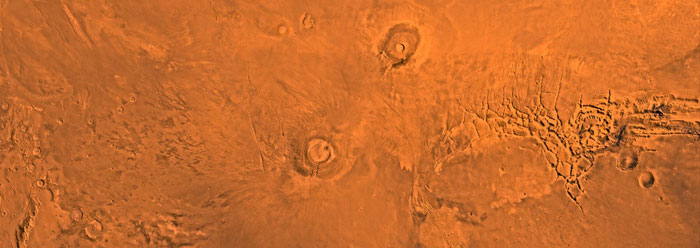For decades, the media and Hollywood have promoted the idea of life on Mars, yet scientific observations have shown that the red planet is utterly inhospitable.1 The surface of Mars is sterile, yet many still hope to find evidence that life could have existed there. Although the planet once harbored liquid water reservoirs that carved canyons and shaped many features across its surface, new research shows that the time in which this occurred was probably very short.2
The NASA study found evidence that at least one giant canyon that was formerly interpreted as having been carved by water, was instead the result of a catastrophic lava flow. The scientists examined the canyon in close detail by combining various high-resolution imaging techniques. According to a NASA press release, at one end of the canyon they found features that "don't form in water-carved channels," as well as what appear to be remnants of volcanic tubes that are clearly lava-formed features.3
The researchers further compared the Martian features with detailed land structures, like lava-formed terraces on the Hawaiian Islands. NASA's Jacob Bleacher, who presented their results at the 41st Annual Lunar and Planetary Science Conference in The Woodlands, Texas, said that within the lava-formed Martian canyon, "We found most of the features that were considered to be diagnostic of water-carved channels on Mars."3
Since it appears that one canyon was misdiagnosed, could other Mars features have formed from lava erosion instead of water? According to the press release, "the team's conclusions do not rule out the possibility of flowing water on Mars."3 Even though this particular canyon looks lava-formed, other evidence, such as alluvial fans, show that liquid water was once present on the planet's surface.
Geologist Andrew Snelling cited a study showing that "Martian flood channel activity involved outbursts of water with huge discharges and associated lava flows." He also referenced another study that found "other landforms related to volcano-ice interactions."2 Since Mars has a polar ice cap, it is possible that a catastrophic lava-bearing episode melted planetary ice at some point in the past.
But Mars has no liquid water today. And it appears that when Mars did have liquid water, it was only there for a short time before a planet-wide catastrophe churned up masses of molten subsurface material. A comparative moment of lava-infused liquid water is not long enough to sustain pre-existing life, let alone build a nursery for cells to "emerge" from chemicals near an otherwise lifeless and harsh planetary surface. Without the long-lasting presence of liquid water, this one life-friendly requirement vaporizes, adding to a long list of other parameters that Mars does not appear to have ever met for the emergence and sustenance of life.
A key implication from this study is that Mars probably never had water long enough to support life. This comes as no surprise to Bible believers, who know from Scripture that only earth was specially created by God to sustain and support a high quality of life.4
References
- Thomas, B. 2008. Searching for the Elusive Man from Mars. Acts & Facts. 37 (7): 14.
- Snelling, A. A. Water Activity on Mars: Landscapes and Sedimentary Strata. Acts & Facts. 36 (2).
- Lava likely made river-like channel on Mars. NASA Goddard Space Flight Center press release, March 4, 2010.
- “While we cannot prove biblically that God did not create life elsewhere, the strong implication of Scripture is that He did not.” Faulkner, D. 2009. Can Life Exist on Other Planets? Acts & Facts. 38 (10): 18-19. For more information, see "The Earth: Unique in All the Universe (Updated)" by Dr. Jerry Bergman, located here.
Image credit: NASA/Jet Propulsion Lab
* Mr. Thomas is Science Writer at the Institute for Creation Research.
Article posted on April 16, 2010.




